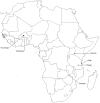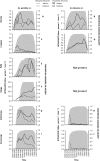Consistently high estimates for the proportion of human exposure to malaria vector populations occurring indoors in rural Africa
- PMID: 23396849
- PMCID: PMC3600624
- DOI: 10.1093/ije/dys214
Consistently high estimates for the proportion of human exposure to malaria vector populations occurring indoors in rural Africa
Abstract
Background: Insecticide-treated nets (ITNs) and indoor residual spraying (IRS) are highly effective tools for controlling malaria transmission in Africa because the most important vectors, from the Anopheles gambiae complex and the A. funestus group, usually prefer biting humans indoors at night.
Methods: Matched surveys of mosquito and human behaviour from six rural sites in Burkina Faso, Tanzania, Zambia, and Kenya, with ITN use ranging from 0.2% to 82.5%, were used to calculate the proportion of human exposure to An. gambiae sensu lato and An. funestus s.l. that occurs indoors (πi), as an indicator of the upper limit of personal protection that indoor vector control measures can provide. This quantity was also estimated through use of a simplified binary analysis (π(i)(B)) so that the proportions of mosquitoes caught indoors (Pi), and between the first and last hours at which most people are indoors (Pfl) could also be calculated as underlying indicators of feeding by mosquitoes indoors or at night, respectively.
Results: The vast majority of human exposure to Anopheles bites occurred indoors (π(i)(B)= 0.79-1.00). Neither An. gambiae s.l. nor An. funestus s.l. strongly preferred feeding indoors (P(i) = 0.40-0.63 and 0.22-0.69, respectively), but they overwhelmingly preferred feeding at times when most humans were indoors (P(fl) = 0.78-1.00 and 0.86-1.00, respectively).
Conclusions: These quantitative summaries of behavioural interactions between humans and mosquitoes constitute a remarkably consistent benchmark with which future observations of vector behaviour can be compared. Longitudinal monitoring of these quantities is vital to evaluate the effectiveness of ITNs and IRS and the need for complementary measures that target vectors outdoors.
Figures



Comment in
-
Commentary: Does a mosquito bite when no one is around to hear it?Int J Epidemiol. 2013 Feb;42(1):247-9. doi: 10.1093/ije/dyt004. Int J Epidemiol. 2013. PMID: 23508414 No abstract available.
References
-
- Lengeler C. Insecticide-treated bed nets and curtains for preventing malaria. Cochrane Database Syst Rev. 2004;2:CD000363. - PubMed
-
- Hii JLK, Smith T, Vounatsou P, et al. Area effects of bednet use in a malaria-endemic area in Papua New Guinea. Trans R Soc Trop Med Hyg. 2001;95:7–13. - PubMed
-
- Magesa SM, Wilkes TJ, Mnzava AEP, et al. Trial of pyrethroid impregnated bednets in an area of Tanzania holoendemic for malaria. Part 2: Effects on the malaria vector population. Acta Tropica. 1991;49:97–108. - PubMed
Publication types
MeSH terms
Substances
LinkOut - more resources
Full Text Sources
Other Literature Sources
Medical
Research Materials
Miscellaneous

